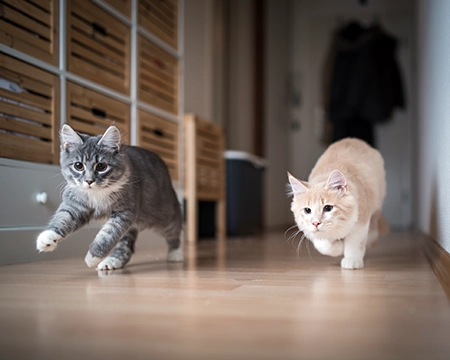If you’ve ever watched your cat race around the house, zooming from one room to the next with a burst of wild energy that seems to come out of nowhere, you’ve just witnessed a classic case of the “cat zoomies.”
The scientific term for cat zoomies is Frenetic Random Activity Period (FRAP).
While entertaining, they are nothing to be concerned about; they are a natural expression of your cat’s playfulness and hunting instincts. Rather than worrying about these energetic outbursts, you can support your cat’s needs by engaging their natural behaviours in a positive way.
In this article, we’ll explore how to encourage healthy play, why zoomies are perfectly normal, and the best ways to support your cat’s innate predatory instincts.
Understanding cat zoomies (Frenetic Random Activity Period - FRAP)
 Cat zoomies refer to spontaneous bursts of high-speed movement, often accompanied by leaping, darting and excited vocalisations.
Cat zoomies refer to spontaneous bursts of high-speed movement, often accompanied by leaping, darting and excited vocalisations.
This behaviour is deeply tied to your cat’s need for physical activity and mental stimulation.
Rather than seeing zoomies as hyperactivity, it’s best to recognise them as a sign of a healthy and happy cat with energy to expend.
Why do cats get the zoomies?
Frenetic random activity period (zoomies) serves as a way for cats to burn off energy and practice their natural hunting behaviours. Here are the most common reasons cats experience these bursts of activity:
- Releasing energy: Indoor cats, especially, may store up excess energy that needs an outlet. Zoomies are a fun and natural way for them to stay active.
- Play and predatory instincts: Cats are born hunters. Even without live prey, they instinctively chase, pounce and sprint. Zoomies can mimic the thrill of the chase.
- Post-nap stretch: Cats sleep for long periods, but when they wake up, they need to stretch and get moving—sometimes leading to zoomies.
- Stimulation and excitement: A cat who’s just had an exciting play session or received extra affection may express their happiness with a zoomie burst.
Tips for supporting your cat’s natural play and hunting instincts
Instead of trying to prevent zoomies, channelling your cat’s energy in constructive ways can lead to a more enriching life. Here are the best ways to support their needs:
1. Schedule Regular Playtime
Frenetic random activity periods often happen when they have too much unused energy. Engage them in daily play sessions using interactive toys such as:
- Wand toys that mimic birds or small prey
- Small balls or mice-shaped toys that encourage chasing
- Laser pointers (used responsibly to avoid frustration). When using laser pointers with your cat, ensure you use this responsibly. Make sure the light lands on the toy that your cat can interact with and ‘catch’.
Playing with your cat multiple times a day—especially before bedtime—can help manage their energy levels and reduce excessive nighttime zoomies.
2. Create an enriching environment
A stimulating environment helps prevent boredom and encourages natural behaviours. Try adding:
- Cat trees and perches: Climbing structures give your cat a chance to explore their vertical space.
- Puzzle feeders: These encourage problem-solving and mimic the challenge of hunting for food.
- Hiding spots and tunnels: Providing places to hide or dart through can make your cat’s zoomies even more fun and engaging.
3. Encourage natural hunting behaviours
Cats have an instinctual desire to stalk, chase, and “capture” their prey. Support this behaviour by:
- Rotating different toys to keep playtime exciting.
- Letting your cat “catch” their toy during interactive play.
- Rewarding successful chases with treats or praise.
4. Respect their independence
While cats love to play, they also enjoy having time to initiate their own activities. Giving them space to explore on their own terms can prevent frustration and support their natural instincts.
5. Manage zoomies at night
If your cat gets zoomies when you’re trying to sleep, try these strategies:
- Increase daytime play sessions to tire them out before bedtime.
- Provide evening meals to mimic the natural rest period that follows hunting and eating.
- Leave out safe nighttime toys so they can entertain themselves without waking you up.
Frenetic random activity period (FRAP) and the litterbox: A normal reaction.
If your cat suddenly gets the zoomies right after using the litterbox, it’s usually harmless, but it could be linked to several things:
- Relief or excitement: Your cat might just feel a sense of relief after eliminating waste, and this behaviour is simply their way of expressing that freedom.
- Cleanliness: Sometimes, the zoomies come after a particularly satisfying or clean bathroom experience. Cats are known for their love of grooming and cleanliness, and they might get a burst of joy after a successful trip to the litterbox.
- Territorial behaviour: In multi-cat households, the zoomies after using the litterbox could be a territorial display. Your cat may be showing their dominance over the newly claimed space.
The bottom line: Zoomies are a sign of a happy cat
Rather than being a cause for concern, cat zoomies are a natural expression of playfulness and instinctual behaviour. By engaging your cat in regular play, providing stimulating environments, and respecting their natural rhythms, you can ensure they live a healthy, enriched life.
Frenetic random activity period (FRAP) FAQs
Are cat zoomies normal?
Yes! They are a normal part of cat behaviour. They are simply your cat’s way of releasing excess energy.
How can I reduce night-time zoomies?
Increase daytime play and provide a consistent feeding schedule to help manage energy levels.
Should I stop my cat from getting the zoomies?
No need! Instead, encourage their playfulness through engaging activities that satisfy their instincts.
Why do some cats get zoomies after using the litterbox?
It’s usually a reaction to relief, excitement, or territorial behaviour. Unless paired with discomfort, it’s nothing to worry about.
How often do cats get the zoomies?
There’s no set frequency—some cats zoom daily, while others do so occasionally, depending on their energy levels.
Are you concerned about your cat?
Contact us today to discuss with your nurse or vet.







